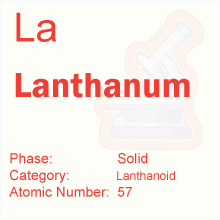 Periodic Table -> Lanthanum
Periodic Table -> LanthanumLanthanum
Lanthanum DetailsLanthanum Symbol: La
Lanthanum Atomic Number: 57
Lanthanum Atomic Weight: 138.9055
What is Lanthanum?
Lanthanum (atomic number 57, symbol La) is a soft, ductile and malleable silvery-white element, which oxidizes rapidly in the air. It belongs to the lanthanide series and is usually found in combination with rare-earth elements such as cerium. Lanthanum is produced from bastnasite and monazite using sophisticated multi-stage extraction techniques.
The element was discovered by Carl Mosander in 1832 when the scientist decomposed cerium nitrate and treated and heated the salt using nitric acid. Mosander isolated a new element from the resulting solution and called it lantana. It was in 1923 when the element was isolated in pure form.
Lanthanum is in the group of the rare-earths, but it is not a rare element meaning that it is present in large quantities. Bastnasite and monazite are the main ores in which the element occurs, but there is less lanthanum in monazite than in bastnasite. The latter was an obscure and rare mineral until 1949, and it was not considered a source of lanthanides. However, a large deposit was discovered at the Mountain Pass during that year. This alerted scientists to the presence of a rare-earth bearing carbonatite, which was a new class of rare-earth deposits. Other examples were soon discovered, in China and Africa in particular.
Regarding commercial applications, the element is used to produce carbon arc lights for projector lights and studio lighting in the motion picture industry. Lanthanum is also employed in the manufacturing of special glasses such as camera lenses.

The element can be found in home equipment such as energy-saving lamps, fluorescent lamps, color televisions, and glasses. La2O2 is used in the manufacturing of optical glasses such as telescope and camera lenses and infrared absorbing glass. It enhances the resistance and malleability of steel when added in small amounts. The salts of lanthanum are used in petroleum refining and zeolite catalysts because at high temperatures, they act to stabilize zeolite. Lanthanum is also added to hydrogen sponge alloys, which can store up hydrogen gas up to four hundred times their volume as part of a reversible absorption process. Every time this happens, heat energy is being released meaning that such alloys can be used in energy conversion applications. Lanthanum is also contained in the pyrophoric alloy mischmetal, used in lighter flints. The alloy contains between 25 percent and 45 percent lanthanum. Different components of lanthanum, chlorides, oxides, and other rare-earths are used in petroleum cracking catalysts and other catalysts. When added to tungsten, lanthanum oxide has application in arc welding electrodes.
The element rarely occurs in nature and only in small amounts, although it is among the more abundant rare-earths. In a working setting, lanthanum can be dangerous because gasses can be inhaled. Long-term exposure causes lung embolisms. In humans, exposure to lanthanum can cause cancer, especially if inhaled. Large amounts of lanthanum in the body are a threat to the proper functioning of the liver. Lanthanum is disposed of in different places, mostly by the petroleum industry. Thrown away household equipment is another way in which lanthanum can enter the environment. It accumulates in water soils and soils, leading to higher concentrations in soil particles, animals, and humans. In water animals, the element causes cell membrane damage, which affects the functioning of the nervous system and reproduction.
You can
link to this page, using the code below:
Periodic Table |
Banks
© ElementsDatabase.com 2015 | Privacy | About | Contact